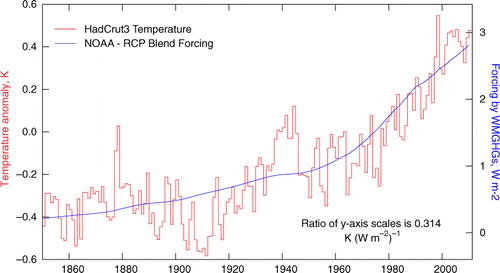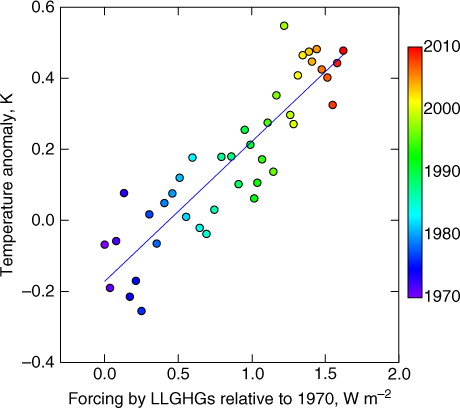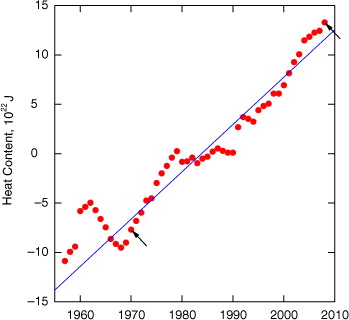Figures & data
Fig. 1 GHG forcing as presented by the Goddard Institute for Space Studies (GISS; http://data.giss.nasa.gov/modelforce/RadF.txt), National Oceanic and Atmospheric Administration (NOAA; http://www.esrl.noaa.gov/gmd/aggi/AGGI_Table.csv) and the Representative Concentration Pathways group (RCP; http://www.pik-potsdam.de/~mmalte/rcps/data/20THCENTURY_MIDYEAR_RADFORCING.xls). All forcings are set equal at 1982 to permit comparison.

Fig. 2 Correlation of global temperature and GHG forcing. Temperature anomaly data are HadCrut3 (Brohan et al., Citation2006, as extended at http://www.cru.uea.ac.uk/cru/data/temperature/). Forcing (blend of RCP and NOAA as discussed in the text) is relative to preindustrial. Ratio of scales of two vertical axes was set by slope of graph of ΔT s vs. forcing.

Fig. 3 Forcing by LLGHGs and non-LLGHG forcing over the time period 1970–2010 as given by the GISS and blended RCP-NOAA data sets.

Fig. 4 Graph of temperature anomaly vs. forcing by LLGHGs for the years 1970–2010 (indicated by colour). Forcing is the average of GISS and blended RCP-NOAA, relative to 1970, . Slope S tr=0.39±0.03 K/(W m−2), where the 1−σ uncertainty is based only on the uncertainty in the fit; forcing is relative to 1970; temperature anomaly HadCrut3 is relative to base period 1961–1990. Correlation coefficient r 2=0.80.

Table 1. Calculation of lower-bound transient and equilibrium sensitivities
Fig. 5 Heat content of the world ocean to depth of 2000 m. Slope (0.48±0.02×1022 J yr−1) of linear fit (blue) to data for years 1970–2008, indicated by arrows, corresponds to heating rate relative to the area of the planet N=0.30±0.01 W m−2. Data from Levitus et al. (Citation2012).

Table 2. Contributions to planetary heating rate